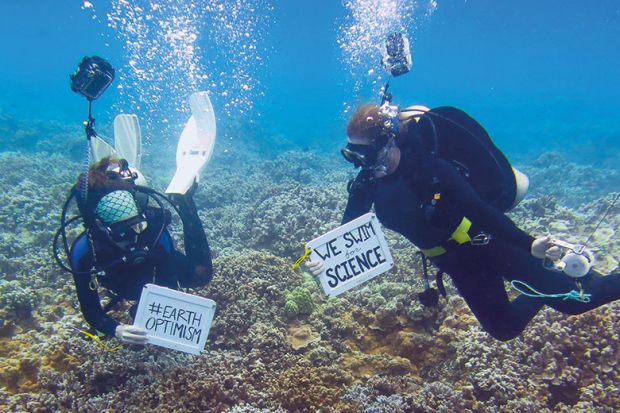More than a million people took part in the first March for Science on 22 April last year. This extensively illustrated book tells some of their stories. It will be a valuable source for anyone engaged in fostering public understanding of science. Most people will, I suspect, be happy to borrow it from the library and browse.
I find it a little troubling that there is a perceived need to support science in this way. But I find it heartening that so many people were prepared to take to the streets in support of a concept, albeit a profound one. The principal march took place in Washington DC and more than 600 other locations also participated. Most were in the US, but there were UK marches in Bristol, Edinburgh, London, Norwich and Cardiff.
More than 40 people each get a single page to explain their reasons for joining the march. They include artists, teachers, representatives of minorities, young and old and an “everyday astronaut”, as well as a wide spectrum of scientists, engineers and medics. Their accounts are fascinating and various. None is overtly political, but their broad range surely tells us something about the community of science.
Participants expressed a vast range of motivations: “I march for science because it can change the world”, “it speaks truth to power”, “to be human is to be curious”, “I am a STEMINIST”, “fact-resistant humans endanger all species”, “without science, it’s just fiction”, “clean water is a resource that should be a given”, “cancer doesn’t wait”, “I take care of giraffes” and “twenty- three years ago science couldn’t save my first premature baby’s life. Ten years ago, advances in science saved my second premature baby”. Echoing Monty Python’s question about the Romans, one asks: “Apart from safe drinking water, clean air, plentiful food, [nine other things] and T-shirts that don’t shrink in the wash, what have scientists and engineers ever done for us?” “Most obscure motivation” prize goes to Daniela Bernal of Santa Cruz, California, who “realised that I could make pyroclastic flow uncomplicated”. My favourite is: “science is the ultimate infrastructure investment”.
The organisers want to see the March of Science become an effective 21st-century champion for its cause (the website is www.marchforscience.com and there is also an online shop). This year’s march took place across the world on 14 April. Concrete topics identified for future action include: building a community of science advocates, advocating for change within scientific institutions and attracting votes for science.
The evidence-based approach to public policy that science represents has long been under attack in the US, mainly from the right, as documented in Chris Mooney’s The Republican War on Science (2005) and Naomi Oreskes and Erik M. Conway’s Merchants of Doubt: How a handful of scientists obscured the truth on issues from tobacco smoke to global warming (2010). President Trump’s sustained assault on environmental protection legislation, as well as his attitude to man-made climate change, provide perhaps the worst (best?) examples. Despite this, the many demonstrations of clear-sighted idealism and the insistence on the importance of science that permeate this book convince me that the US is probably still the best place in the world to do science.
Richard Joyner is emeritus professor of chemistry at Nottingham Trent University.
Science not Silence: Voices from the March for Science Movement
Edited by Stephanie Fine Sasse and Lucky Tran
MIT Press, 176pp, £11.99
ISBN 9780262038102
Published 17 April 2018
Register to continue
Why register?
- Registration is free and only takes a moment
- Once registered, you can read 3 articles a month
- Sign up for our newsletter
Subscribe
Or subscribe for unlimited access to:
- Unlimited access to news, views, insights & reviews
- Digital editions
- Digital access to THE’s university and college rankings analysis
Already registered or a current subscriber? Login








